- News
- Reviews
- Bikes
- Accessories
- Accessories - misc
- Computer mounts
- Bags
- Bar ends
- Bike bags & cases
- Bottle cages
- Bottles
- Cameras
- Car racks
- Child seats
- Computers
- Glasses
- GPS units
- Helmets
- Lights - front
- Lights - rear
- Lights - sets
- Locks
- Mirrors
- Mudguards
- Racks
- Pumps & CO2 inflators
- Puncture kits
- Reflectives
- Smart watches
- Stands and racks
- Trailers
- Clothing
- Components
- Bar tape & grips
- Bottom brackets
- Brake & gear cables
- Brake & STI levers
- Brake pads & spares
- Brakes
- Cassettes & freewheels
- Chains
- Chainsets & chainrings
- Derailleurs - front
- Derailleurs - rear
- Forks
- Gear levers & shifters
- Groupsets
- Handlebars & extensions
- Headsets
- Hubs
- Inner tubes
- Pedals
- Quick releases & skewers
- Saddles
- Seatposts
- Stems
- Wheels
- Tyres
- Health, fitness and nutrition
- Tools and workshop
- Miscellaneous
- Buyers Guides
- Features
- Forum
- Recommends
- Podcast
TECH NEWS
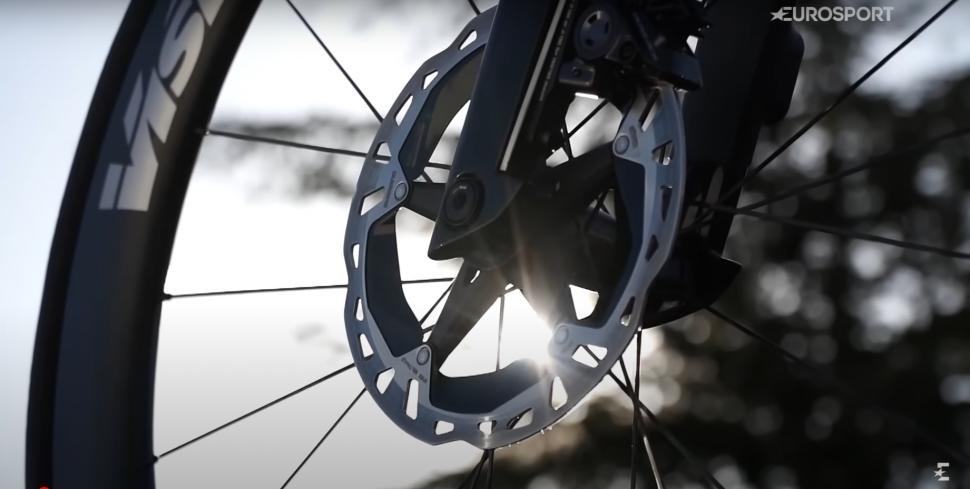 2022 TdF TBV Vision Shimano 180mm disc rotor
2022 TdF TBV Vision Shimano 180mm disc rotorIs bigger better? 180mm disc brake rotor spotted on Tour de France bike
As we hit the third rest day, Team Bahrain Victorious has so far found a stage win at this year's Tour de France elusive, but could it have found a solution in the use of a huge 180mm front disc rotor.
Fred Wright has come closest to a stage victory, finishing second on Stage 13, but many Bahrain Victorious riders have only been noticeable by their absence. Even Matej Mohoric doesn't appear to be his usual self and it's been down to Tom Pidcock of Ineos Grenadiers to impress on the descents.
But Bahrain Victorious has a new weapon in its armoury. We spotted one of their bikes just before the start of Stage 14 fitted with a huge 180mm front disc rotor.
Typically in the pro peloton, we see riders and teams opting for a 160mm disc at the front and a 140mm disc at the rear. This is often what bikes get sold with as standard and seems to strike a good balance between braking power, heat dissipation and weight.
We do sometimes see smaller riders using a 140mm disc at both the front and the rear as their lower mass means they don't need as much braking power and are less likely to overheat a rotor even on the Tour's long descents.
> How fast!? We analyse Tom Pidcock's stage-winning Strava file
Many teams like all their riders to be using a consistent brake rotor size as it makes wheel swaps much simpler – any rider can have any wheel off the roof of the team car. Using 160mm and 140mm rotors also makes it more likely that the neutral service will be able to help the rider in an emergency. This year neutral service is provided by Shimano which has taken over from Mavic.
> Did disc brakes get Pogacar dropped?
Shimano also supplies Team Bahrain Victorious, using the Dura-Ace R9200 12-speed groupset at this year's Tour. The groupset uses M900 Ice-Tech Freeze rotors borrowed from the brand's XTR top-of-the-range mountain bike (MTB) groupset.
Being designed for mountain bikes, there are some huge sizes available but Shimano only sells 140 or 160mm for road use. Both of those options feature four arms connecting the braking surface to the centre lock whereas the one pictured on the Bahrain Victorious bike clearly uses five as found on the 180mm+ rotors.
> Review: Shimano Dura-Ace R9200 groupset
The move to the MTB rotors comes after complaints of the older style Dura-Ace discs warping when hot and then rubbing on the pads. In my experience, it is a definite improvement and when combined with the additional 10% pad clearance of the latest callipers, it does almost eliminate the problem with a good set-up.
> Chris Froome STILL has disc brake problems
So why would anyone use a bigger rotor? Well, we've been asking ourselves the same question as this change to 180/160mm rotors is likely costing the rider 60-70g when compared to a 160/140mm setup.
We do often see huge rotors used on mountain bikes because they provide greater leverage and torque to stop the rotation due to the fact that they are further away from the rotating axle (the hub). In plain English, that means more braking power but as the limiting factor in road riding is usually the tyre's contact with the road, is that not a bit unnecessary?
Well, we think yes but the unknown Bahrain Victorious rider was clearly quite set on the idea as the bike requires a different calliper mount and adds the risk of not being able to find a spare wheel if he punctured. Bigger rotors do also have a larger braking surface to dissipate heat which means more consistent braking performance even after multiple heavy braking zones as is typical of a hairpin descent, for example.
> Everything you need to know about disc brakes
From previous races, we know that Bahrain Victorious aren't afraid to buck the trend and try something new. For example, at Milan-San Remo, Matej Mohoric used a dropper post on his way to victory. Is there anything we can't steal from the mountain bikers? Dropper posts, fatter tyres, tubeless tech and now big discs. What do you think is next!?
> UCI confirms that Mohoric's dropper post was within the rules
Let us know your thoughts on 180mm discs and what mountain bike tech we roadies will steal next in the comments below...
Jamie has been riding bikes since a tender age but really caught the bug for racing and reviewing whilst studying towards a master's in Mechanical engineering at Swansea University. Having graduated, he decided he really quite liked working with bikes and is now a full-time addition to the road.cc team. When not writing about tech news or working on the Youtube channel, you can still find him racing local crits trying to cling on to his cat 2 licence...and missing every break going...
Latest Comments
- matthewn5 7 min 20 sec ago
An update: Campagnolo recommends Loctite for press-fit BBs: https://www.campagnolo.com/on/demandware.static/-/Library-Sites-campagno...
- ChrisGoddard 7 min 46 sec ago
Hi Dave, I subscribed yesterday but still can't access the game
- OnYerBike 10 min 9 sec ago
Maybe we cannot entirely eliminate fatalities, but that doesn't mean we shouldn't try (that is the goal of "Vision Zero")....
- Andrewbanshee 47 min 9 sec ago
The UK and new infra. Sigh. Optical illusion infra. Sigh. Accident waiting to happen. Sigh....
- Hirsute 1 hour 13 min ago
Good job the telescope was on a massive bollard plinth otherwise a few KSIs. https://www.youtube.com/watch?v=lIqUgFaM26w (first clip)
- Rendel Harris 1 hour 36 min ago
Looks to me as if he's totally understood the spirit of the jersey, judging by that comment.
- brooksby 1 hour 57 min ago
Dear "member of the road.cc staff" - is there any chance you could publish a transcript of this episode? - thanks!
- Freddy56 2 hours 8 min ago
I am a bianchi owner, A lovely Sprint with 105 hydraulic but this has concealed cables on a bike that isn't build for speed?
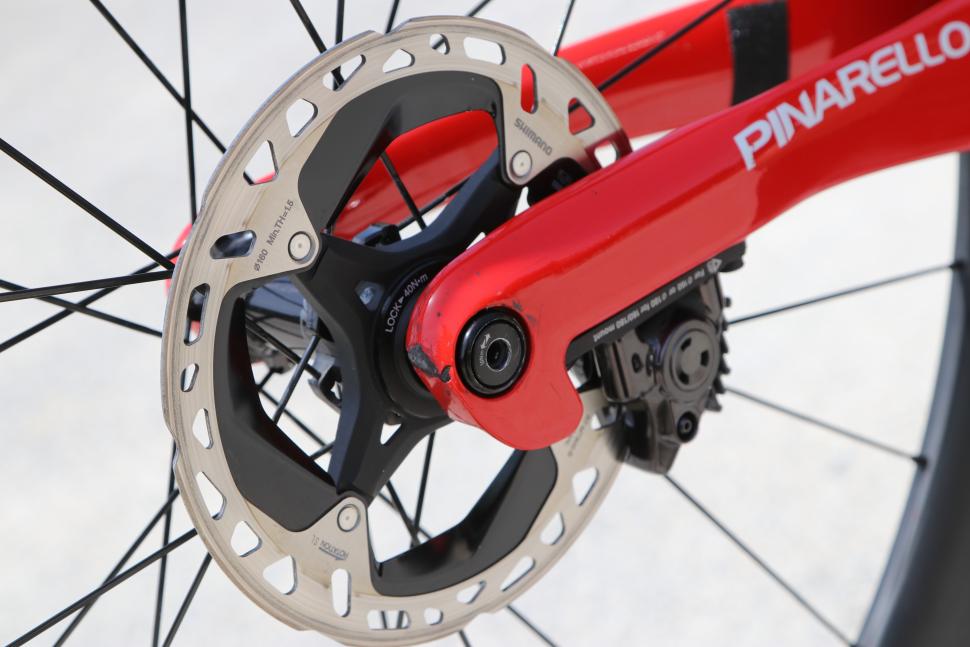
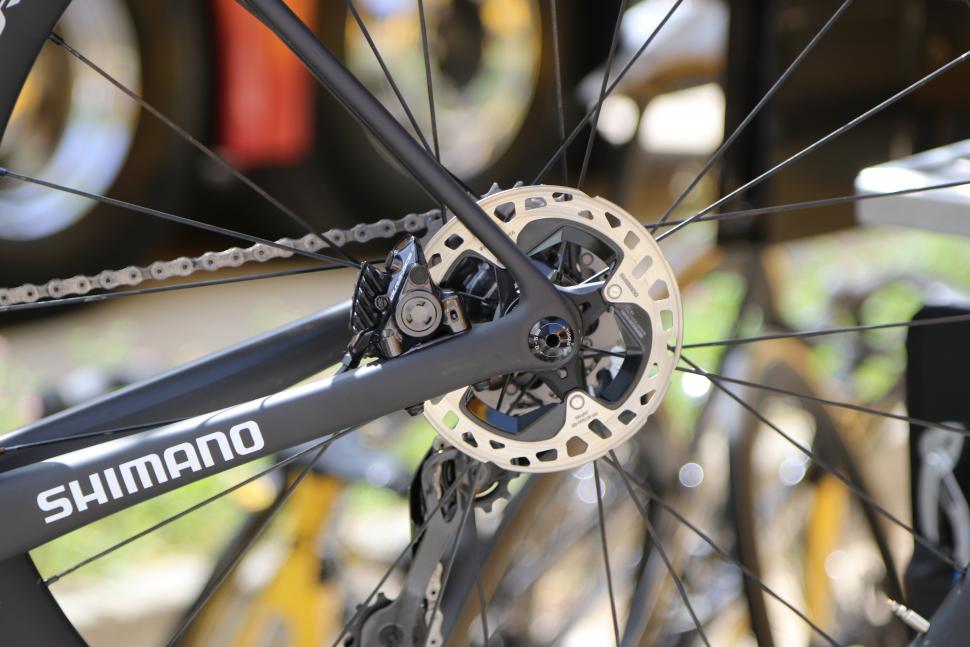

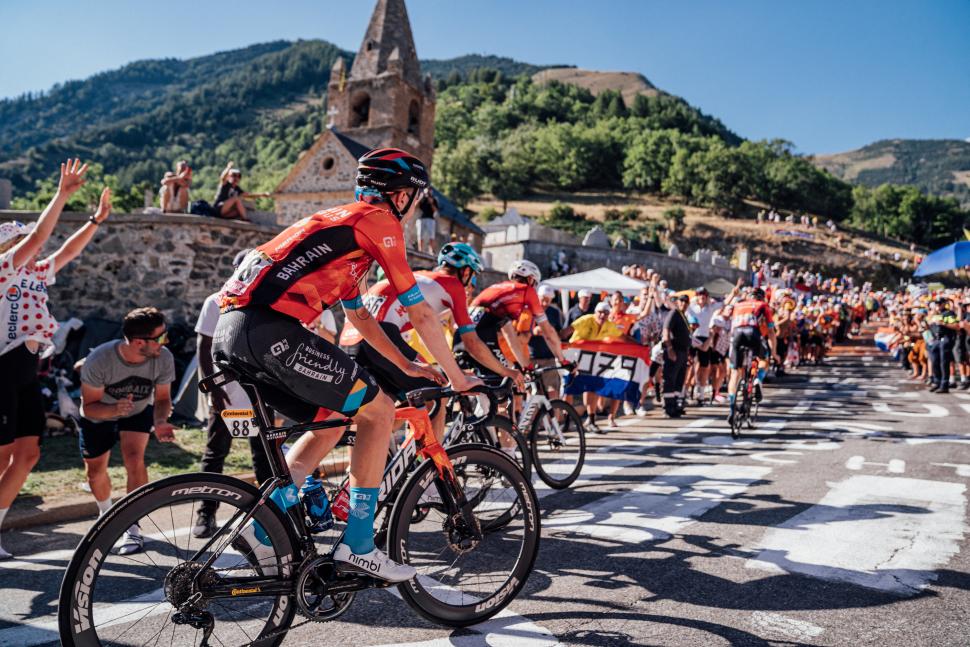
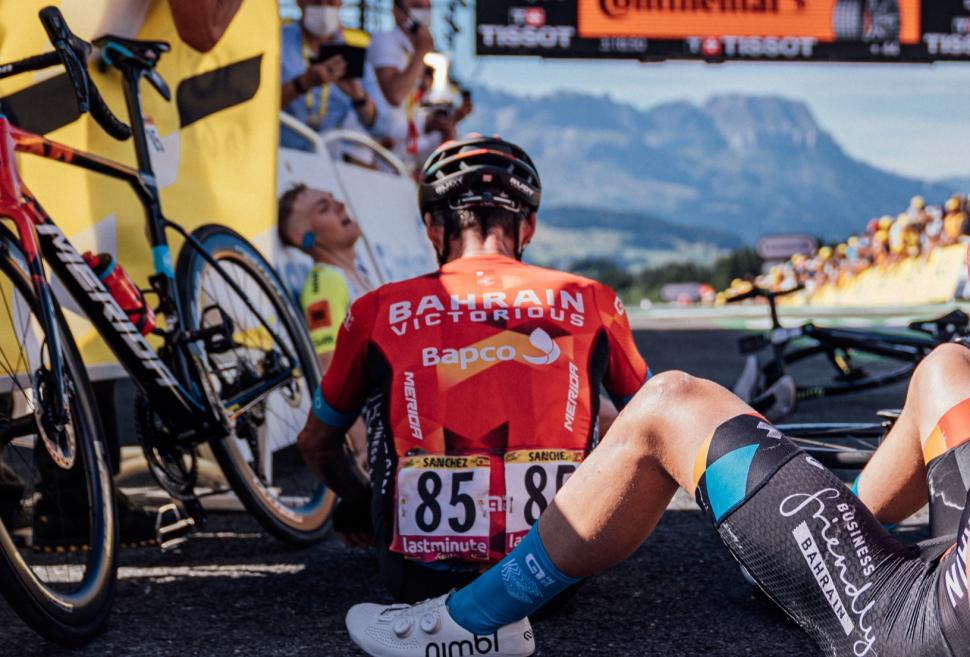
Add new comment
39 comments
Is warping actually an issue with discs? I know that on cars, what feels like warping is actually deposits on the discs from the pads overheating.
Even at 40c, race temperatures are surely only 10c over what might be reasonably expected, and would only make the temp of the disc itself a small % higher than it would reach under braking in normal operating conditions.
Yes, I get it on my 2017 Ultegra discs. If I brake hard I get a ting which then goes after a few rotations of cooling. Clearly the disc warping, not dirt. Dirt on the discs causes squeals and rasps, but also you can clear it by braking, braking does, obviously, not clean up the warp.
So... carbon-ceramic disc brakes on road bikes, when?
I doubt it. Carbon doesn't work very well as a braking surface at normal temperatures, ask anyone with carbon rims without a metal insert, especially in the wet. If carbon was a solution, it would already be a big thing in the MTB world where brakes get a hammering.
I think that Shimano just need to be a bit cleverer with disc construction. As to pads, plenty of variety out there with sintered and ceramic all out there as well as resin for low stress situations. I prefer resin on my road bike because I don't do much hard stopping, but currently using some cheap ceramic and they seem to work well.
If it is a proper 'ting' sound lik a bell ringing and you have two piece discs its probably the outer part moving with respect to the inner on the rivets as it cools, I get this while stationary at a junction at the bottom of a local hill so it can't be catching on the pads in that situation.
No it's the proper "ting" sound of a rotor catching on the pads while moving
I have sat at the bottom of the Chute near Llangollen when a group of us cooked our brakes. The GRX 400 on that bike got super-hot but didn't rub. Matey's Ultegra rotor went purple, but didn't rub, so it does seem to be a subtle manufacturing or possibly wear issue.
I guess these riders were already cutting close to the limits as it was , so ten c might actually tip them over. It will also reduce how quickly the heat can dissipate so the repeated heat cycling might lead to high temps. Sounds possible that this can help.
I very much suspect it's more complicated than "the air is 10C warmer and therefore the discs will be 10C warmer".
Firstly the temperature the discs reach during use is about heat dissipation. The higher the ambient temperature, the slower the dissipation.
Secondly whilst the air temperature might only be a bit higher, I suspect the disc rotors (even when not being used) will be getting hotter from the sunlight - touch a metal object in the sun (e.g. a parked car's bonnet) and it feels hot. Obviously a disc rotor is moving and so will probably cool down a bit compared to a stationary metal object, but still I think there will be some effect.
I also think disc brakes on bikes have much closer tolerances than those on cars and are generally much thinner/lighter, so they are likely to be more susceptible to warping than a car's disc brakes.
They're saying the road surface gets to 60 degrees, so the air down there is probably a touch warmer than the official meteo temp. I recall a minibus trip in southern Egypt - you could feel the heat coming up through the floor!
Pages